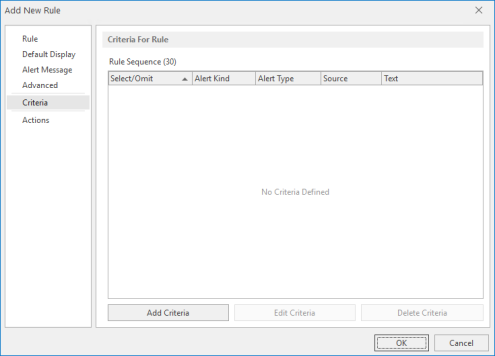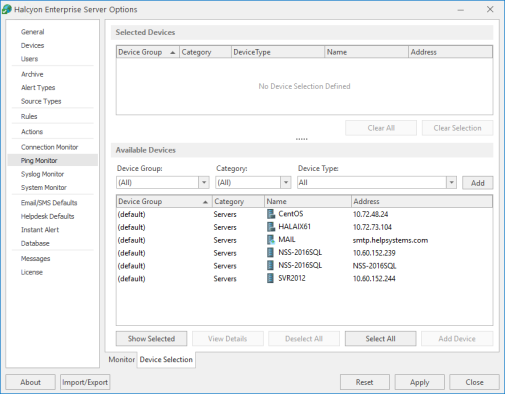Adding and Editing Rule Criteria
Options on the Add New Rule/Edit Rule Criteria page define rule selection criteria. These are the qualifications that the rule must meet if an alert is to be raised.
Summary details of rule criteria are displayed in a five-column table:

Select/Omit
Displays whether the criteria is selected or omitted from the rule.
Alert Kind
Displays the kind of alert that is raised by the rule criteria.
Alert Type
Displays the type of alert raised by the rule criteria.
Source
Displays the source device that is being monitored by the rule criteria.
Text
Displays the text used in the event that the rule criteria generates an alert.
Sorting columns
Column order can be rearranged by left-clicking on a column heading and keeping the mouse button depressed, dragging the column to the new position and releasing the button. Information in each column can be sorted in ascending or descending order by clicking on each column title to change the sequence.
Adding Criteria
Rule criteria is added in the Add New Criteria dialog and edited in the Edit Criteria dialog. These dialogs are displayed by clicking Add Criteria or Edit Criteria (edit is enabled for any selected items displayed in the table). Options on both dialogs are identical.
Click Add Criteria to create a new selection criterion for the rule. Multiple criteria can be specified for a single rule.
Criteria Details section
Criteria Type
Choose whether to select or omit this rule from action processing.
- Select: Check this option to include this rule for action processing.
- Omit: Check this option to exclude this rule from action processing. Events matching similar criteria in other rules may still be selected for processing.
Alert Kind
Choose the kind of alert that is raised for this rule.
- Inquiry: These are alerts that usually require some form of action to be taken on the part of the user.
- Information: These are alerts that are raised and provide information to the user
- Both: Both kinds of alert are raised. This is the default setting.
Alert Type
Define the alert type level for this rule based on selected conditional parameters (equals, less than, greater than, etc.). Priority is taken from the Alert Type table on the - Alert Settings page.
Parameter | Alert Type | Result |
= | Any Type | All Alert Types are selected |
> | Error | All alert types with a higher priority of error are selected |
= | Critical | Only critical alerts are selected |
Source Type
Define the source type based on conditional parameters (equal to, not equal to).
|
Parameter |
Source Type |
Result |
|
= |
Any Type |
All Source Types are selected |
|
<> |
Ping Monitor |
All Source Types except Ping Monitor are selected |
|
= |
Ping Monitor |
Only the Ping Monitor Source Type is selected |
Alert Text
Enter the alert text based on conditional parameters (equals, less than, greater than, etc.). Wildcard characters can be used when defining the ‘Alert Text’. This option is selected via the drop-down list.
Search Text From Position ... For ... Characters
Allows the fine tuning of the search for specific alert text by specifying a starting position from which to search and for a specified number of characters.
Alert Details section
The Alert Details section is used to set textual information for alerts raised by the rule criteria.
Details Text
Define the details text. This can be generic or free text and can also use specific textual values that vary depending on the type of alert rule that is being defined. Wildcard characters can be used when defining this text.
Details Value
Define the details value based on conditional parameters (equals, less than, greater than, etc.) when used in combination with entry in the Details Text field. Wildcard characters can be used when defining the details value.
Wildcard Characters settings
The wildcard characters area is used to define characters which are then used as substitutes for search spans or single characters.
Use ... As A Substitute For Zero or more Characters
Enter the character to use as a substitute for this search span. '*' is defined as the default search span character.
Use ... As A Substitute For A Single Character
Enter the character to use as a substitute for a single character. '?' is defined as the default single wildcard character.
The Device Selection tab is used to select the Devices to which the monitor connects and raises alerts if the success percentage figure is not attained.

Selected Devices section
This section shows the devices that are currently selected for use with the monitor. When this tab is opened for the first time, this section is empty.
Information is listed in five columns:
- Device Group: Displays the name of the Device Group to which the device belongs.
- Category: Displays the category in which the device is defined.
- Device Type: Displays the Device Type of the device.
- Name: Displays the name of the device.
- Address: Displays the IP Address or Host name of the device.
Clear All
Click Clear All to remove all of the currently selected devices from selection.
Clear Selection
Highlight a device in the Selected Devices section and click Clear Selection to remove this device from selection. Multiple devices may be selected in one action.
Sorting columns
Column order can be rearranged by left-clicking on a column heading and keeping the mouse button depressed, dragging the column to the new position and releasing the button. Information in each column can be sorted in ascending or descending order by clicking on each column title to change the sequence.
Available Devices section
This section lists all of the devices that have been defined in Device Manager.
Filter options
These options allow the filtering of available devices on the network in order to restrict the list of available devices to just those that meet the filter criteria.
The categories comprise:
- Device Group: Device groups are collections of similar devices, such as all those that belong to a specific department. Device groups are set up and maintained in Device Manager
- Category: Devices, such as servers that can be divided into specific types. Items listed here are by default. No other items can be added to this list.
- Device Type: Device types, such as proxy servers are listed on this drop down and comprise a mix of default items and any other items identified on the network, which are automatically added to this list.
Add Device
To load a device into the Selected Devices section of this page, select the required device in the Available Devices section and click Add Device to move it into the Selected Devices section.
Show/Hide Selected
Click to show in the Available Devices section, only those devices not already listed in the Selected Devices table. This avoids duplicating device information in both tables. Click again to show all available devices, including those that have already been selected.
View Details
This button is used to open the View Device dialog, which displays the attributes of a selected device. No amendments can be made on this display. If changes are required, use Edit Device in Device Manager.
Deselect All
Click to deselect all of the currently selected devices in the Available Devices section.
Select All
Click to select all of the devices listed in the Available Devices section.
Click OK to apply the criteria to this rule.